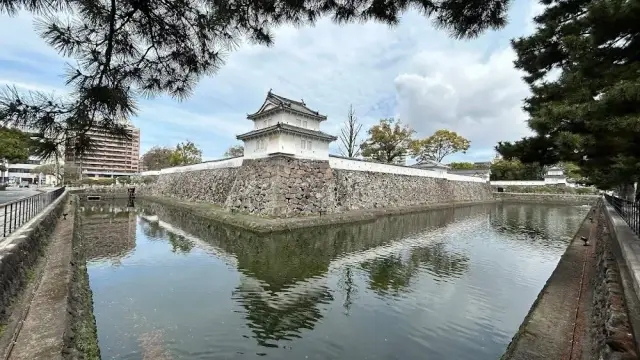https://www.dekitabi.com/itinerary/oita-city-essential-tour
Nestled in the heart of Oita Prefecture, Japan, a fascinating blend of historical landmarks and cultural treasures awaits travelers. Among the highlights of this region are the Oita Bank Red Brick Building, Funai Castle Ruins, Yusuhara Hachiman Shrine, and Sasamut Shrine. Each site offers a unique glimpse into Japan’s rich past and vibrant traditions. Here’s an in-depth look at these captivating destinations that promise to enrich your understanding of Oita’s heritage.
Oita Bank Red Brick Building

https://www.dekitabi.com/attraction/oita-bank-red-brick-building
The Oita Bank Red Brick Building stands as a testament to the architectural elegance of the early 20th century. Completed in 1928, this historic structure was once the headquarters of the Oita Bank, reflecting the period’s economic prosperity and architectural style. The building’s red brick facade and intricate detailing exemplify the Western influence that permeated Japanese architecture during the Taisho era.
Today, the Oita Bank Red Brick Building has been preserved as a cultural landmark, offering visitors a chance to step back in time. Its meticulously maintained exterior and charming interior spaces provide a glimpse into the opulence of the early 1900s. Guided tours reveal the building’s historical significance and its role in the development of Oita’s financial district. The site is not only an architectural marvel but also a living museum of Japan’s banking history.
Funai Castle Ruins

https://www.dekitabi.com/attraction/oita-funai-castle-ruins
The Funai Castle Ruins, located in the heart of Oita City, are a remarkable historical site that transports visitors to Japan’s feudal era. Originally constructed in the early 17th century by the Matsudaira clan, Funai Castle was a strategic fortification and administrative center during the Edo period. Though the castle was dismantled in the late 19th century, its ruins still offer a glimpse into its past grandeur.
Exploring the Funai Castle Ruins provides a fascinating look at Japanese castle architecture and urban planning. Visitors can wander through the remnants of the castle’s walls, gates, and moats, which reveal the defensive strategies and design principles of the time. The site also offers panoramic views of Oita City, making it an excellent spot for photography and reflection. The surrounding park area, with its cherry blossoms in spring, adds to the charm of this historical site.
Yusuhara Hachiman Shrine

https://www.dekitabi.com/attraction/yusuhara-hachimangu-shrine
Yusuhara Hachiman Shrine, nestled in the picturesque surroundings of Oita Prefecture, is a revered Shinto shrine dedicated to Hachiman, the deity of war and protector of the samurai. Established in the 8th century, this shrine has been a place of worship and cultural significance for centuries. Its serene setting amidst lush greenery provides a tranquil escape from the bustle of everyday life.
The shrine’s architectural design is a fine example of traditional Shinto craftsmanship, with its elegantly curved roofs and wooden structures. Visitors can participate in various Shinto rituals and festivals, which are held throughout the year. These include the annual Yusuhara Hachiman Matsuri, a vibrant celebration featuring traditional performances and local cuisine. The shrine is also known for its sacred cedar trees, which are believed to bring good fortune and longevity to those who visit.
Sasamut Shrine

https://www.dekitabi.com/attraction/sasamuta-shrine
Sasamut Shrine, located in a serene rural setting, is another gem of Oita’s cultural heritage. This shrine, dedicated to the deity of agriculture and fertility, plays a vital role in the local community’s spiritual and cultural practices. Established centuries ago, Sasamut Shrine has been a place of worship and celebration for generations.
The shrine’s design reflects traditional Shinto aesthetics, with its simple yet elegant wooden structures and well-maintained grounds. Visitors can enjoy the peaceful atmosphere of the shrine, which is surrounded by beautiful natural landscapes. Sasamut Shrine is particularly known for its seasonal festivals, which highlight local traditions and customs. The most notable event is the Sasamut Matsuri, where visitors can experience traditional music, dance, and food.
Planning Your Visit
Each of these sites—Oita Bank Red Brick Building, Funai Castle Ruins, Yusuhara Hachiman Shrine, and Sasamut Shrine—offers a unique experience for those interested in exploring Japan’s rich history and culture. Whether you’re captivated by architectural marvels, intrigued by feudal history, or seeking spiritual solace, these landmarks provide diverse experiences that highlight the multifaceted heritage of Oita Prefecture.
To make the most of your visit, consider exploring these sites in a logical itinerary, allowing ample time to absorb the history and cultural significance of each location. Guided tours and local information centers can enhance your understanding and provide additional context to the sites you visit.
In summary, Oita Prefecture’s historical and cultural landmarks offer a profound glimpse into Japan’s past. From the grandeur of the Oita Bank Red Brick Building to the serene beauty of Yusuhara Hachiman Shrine and Sasamut Shrine, these destinations promise a rich and memorable travel experience. Embrace the opportunity to explore these treasures and immerse yourself in the captivating heritage of Oita.


Leave a Reply